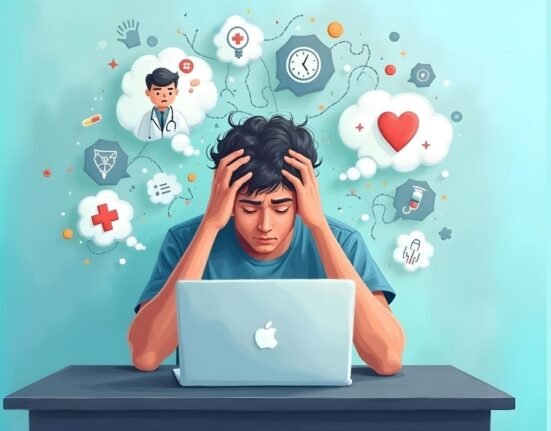Cognitive Behavioral Therapy Techniques for Anxiety
Cognitive behavioural therapy commonly known as CBT is a popular form of psychological treatment used by most of today’s mental health professionals. It is a talking therapy that can help one manage their problems by changing the way they think and behave. It is most preferably used for diagnosing anxiety and depression but can also be used to treat other mental illnesses. Aaron Beck was the first CBT therapist who was a psychiatrist practising psychoanalysis before. CBT therapists assist clients in becoming their therapists by teaching specific techniques for self-practice.
What is Anxiety?
American Psychological Association defined Anxiety as an emotion characterized by feelings of tension, worried thoughts, and physical changes like increased blood pressure. Many of us use the terms anxiety and stress interchangeably, but they have distinct meanings. Stress is a response to a threat, whereas anxiety is a stress reaction. Within the realm of CBT, numerous techniques address mental health issues, with a specific focus on anxiety. Key methods include psychoeducation, journaling, exposure therapy, realistic thinking, relaxation strategies, and mindfulness, all tailored to alleviate anxiety symptoms.
Techniques used in CBT
Psychoeducation helps one acquire knowledge of the causes of anxiety and what exactly is anxiety. In this era, the term “anxiety” is widespread and heard by many, including children. However, there is no guarantee that they fully understand its meaning; often, people, both young and adult, might confuse it with negative emotions. Some adults and young individuals might not have encountered the term “anxiety” at all. On a very clear note, psychoeducation won’t make anxiety disappear. It’s just the first step in treating anxiety. Psychoeducation is one of the techniques used in the first session by the CBT therapist.
1. Journalling
Journalling can be done by anyone independently there is no necessary for any therapists who have to assist you or neither you should have any illness. It is like keeping a record of your thoughts, ideas, moods and experiences. This can help an individual with anxiety to reflect on himself/herself. There are chances that by journalling one can treat their anxiety by themselves. By recording all their cognition processes one can identify the pattern of what makes them anxious, when they usually experience anxiety and under what circumstances. After being self-aware of the causes and all it puts one in control of oneself.
A gratitude journal is essential for cultivating positive habits. Acknowledging and appreciating the good things in life promotes a positive mindset, reduces stress, and boosts overall well-being. This simple practice fosters contentment, resilience, and a more optimistic outlook, making it a must-have tool for lasting happiness. Buy this Beautiful nature-themed Gratitude Journal for Better Mental Health today.
2. Exposure therapy
Exposure therapy is often used to treat phobias which means irrational fear of anything. People with phobias always avoid and try to escape the situations they are afraid of so in this therapy they are exposed to the things they fear in a few series. For example, if a person is afraid of spiders the individual is not directly exposed to the spiders instead first, they are shown pictures of it, then maybe a toy of it and at last a real spider. In each step, they have to completely be not afraid of it to move on to the next stage.
3. Realistic Thinking
Realistic thinking is all about replacing negative and irrational thoughts with realistic ideas. Our brain works well with balanced ideas and concepts which aids with anxiety. One of the main characteristics of anxiety is overthinking which leads to exaggerated thoughts so replacing realistic thoughts reduces the anxiety.
4. Relaxation Techniques
In relaxation techniques, one of the most used techniques is the Progressive Muscle Relaxation technique which requires one to contract and then relax different groups of muscles progressively. The progressive muscle relaxation technique was developed by Edmund Jacobson so it is also known as Jacobsonian relaxation and neuromuscular relaxation as the nervous system is involved in the contraction of the muscles. It is said that PMR also helps with insomnia.
There are other relaxation techniques which has been recommended by CBT therapists as Biofeedback mechanism diaphragmatic breathing, yoga and Tai Chi. Diaphragmatic breathing is all about consciously breathing i.e., exhaling and inhaling with the focus on it hence making one mindful about their breathing. Yoga which originated from India has a lot of exercises in itself that can be used for relaxation one of the very famous is pranayama which is again a breathing technique but the difference here is the hands are used. Tai Chi was originally developed in Chinese tradition for self-defense but it can be used as a relaxation technique as it involves gentle stretching of the body.
5. Mindfulness
The last and one of the most talked about in today’s workplaces is mindfulness which can also be classified under one of the relaxation techniques. Mindfulness is literally at present in Indian Psychology it’s said that our mind which is known as manas always wanders either in the past or future but never in the present. So being in the present makes one focus on the things that have to be handled at that specific moment instead of worrying about things that you may not even face. All these techniques are used by CBT therapists for the well-being of their clients though each of these are recommended to the clients based on their suitability.
In conclusion, Cognitive Behavioral Therapy (CBT) offers a range of techniques to effectively address anxiety and other mental health issues. Through psychoeducation, journaling, exposure therapy, realistic thinking, relaxation strategies, and mindfulness, individuals gain self-awareness, control, and healthier thought patterns. CBT therapists play a crucial role in guiding clients through these methods, tailoring their approach to each individual’s needs. By empowering individuals to understand and manage their anxiety, CBT equips them with valuable tools for navigating life’s challenges with resilience and mental well-being.













Leave feedback about this